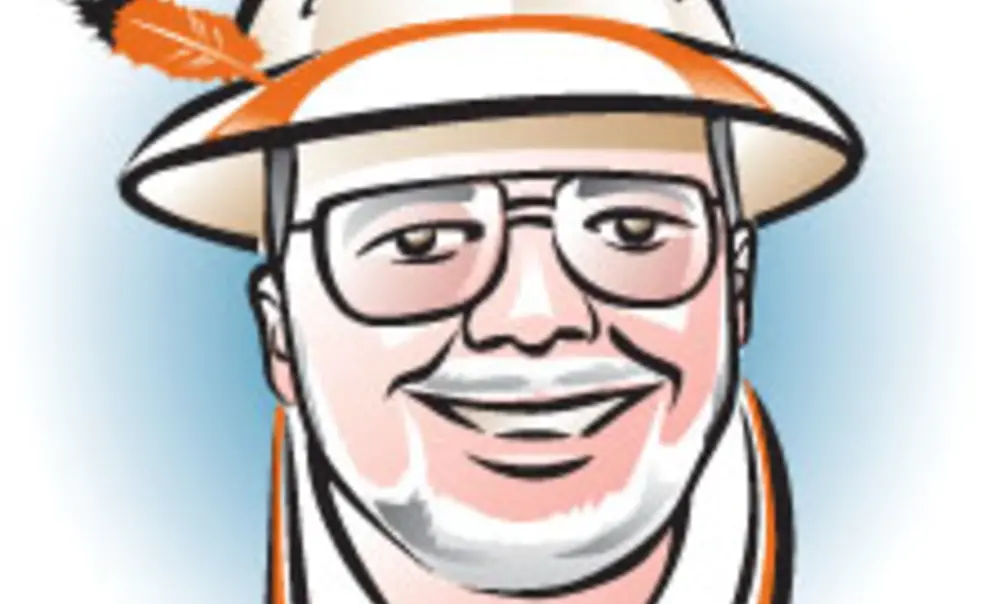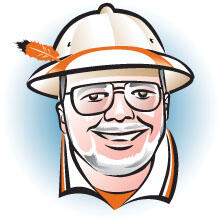Editor's note: Can you separate the real Prince stories from the joke ones? Try our quiz at the end of this column.
Months ago, in a fit of characteristic hyperefficiency, I figured out that the cover date on this edition of Your Favorite Periodical would be April 1, 2009. With time on my side, I ran breathlessly (my only option for the last few years) to the Beloved Editors and laid out my brilliant plan for a joke edition of the PAW, to regale alums across the nation, among all nations and across the known universe and, not coincidentally in a recession, generate molto bucks for those grimly beleaguered folks in the development office.
Regardless of appearances, this is not that joke issue. Let us simply say my suggestion fell on infertile ground, perhaps soured by a buyers’ market in journalistic employment, but in any event it was a major nonstarter. I was mystified, not that that’s hard to achieve.
Now I know why. It came to me Jan. 14 when I digitally unfolded my online Daily Princetonian and, for starters, glimpsed the portrait of our good leader Dr. Tilghman succumbing to the enthusiastic spirits of Reunions, as it were. Yes indeedy, it was the annual Prince joke issue. It dawned on me that many of my henchfolk here at PAW are veterans of that august literary tradition, and thus it was clear why they never, ever wanted to go near it again.
Which is ironic since this year’s outgoing ’09 Prince board put together a truly snazzy issue that effectively covered the Princeton waterfront and actually contained humor, not a consistent part of the joke tradition. It had Eliot Spitzer ’81 rumored to succeed Anne-Marie Slaughter ’80 as dean of the Wilson School. It had Princo, trying to rebound from its 2008 losses, investing in Somali pirates. It had the Tiger Band training to carry weapons, presumably for the Citadel rematch, and a coincidental report of the club rifle team “going Capone” on the fencers. The lead story reported the new White House basketball team beating the Princeton varsity 62-54, with Hillary “Ice Box” Clinton leading the way with 20 points and 18 million cracks in the glass backboard. President Obama had “ten points, five assists, and $700 million in bailout loans.” Good stuff.
The Prince ’s joke impetus, blindingly obvious if you’ve ever hung out in their offices for a half hour, first migrated to the printed page in the Roaring ’20s, complete with its own banner declaring itself “The Gaily Printsanything.” Satirizing such obvious targets as the new Chapel (a huge Gothic monument to antimaterialism) and the no-car rule, it was the final edition of the outgoing editorial board at the end of the first semester. Somewhere around the same time, single joke stories began to appear on April Fool’s Day when the new board was in the mood. The bottom dropped out of the new satirical tradition during the somber ’30s; examples then are few and pallid.
But with the resuscitation of rah-rah collegiality after World War II came ever more creative joke issues (which often confused the public because the mid-January timing is arbitrary to anyone outside the Prince, and no separate banner was used in those days) and April Fool gags (which get complicated when the “Sunday April 1” edition is delivered on Monday April 2 or whatever).
Some of the in-jokes hardly stand the test of time. I’ve seen befuddled Prince alumni look at articles their own boards wrote, unable to recall whether they were satire or fact. Of course, sprinkled across the years are still many imaginative examples that rival this January’s tour de farce .
- On “Sunday April 1, 1951,” the New Jersey Anti-Alcohol League protested the Chemical Engineering department’s new 50-gallon still, because you know what a still is for.
- On Jan. 28, 1953, the outgoing board reported that new librarian William Dix was accepting a (previously declined) donation of scripts from Marilyn Monroe, which not surprisingly would include her visit to present them. “Marilyn – I mean Miss Monroe – is much more popular than Princeton University. Thus, this purchase should help Princeton’s good name,” according to Dix.
- The January 26, 1961, joke issue was dated 1971, purporting to present news 10 years later. It noted that parietals had been extended ’til midnight, but made no mention of the outlandish notion of coeducation (which in the real world actually happened). It also reported the continuing (i.e., now 15-year-old) saga of the $53 million capital campaign, which had devolved into “Pennies for Princeton,” whereby tiger-shaped banks were sent to the little siblings of undergrads to collect their change.
- In the most graphically complex joke issue I’ve seen, the entire Prince on Jan. 19, 1987, was done in the style and typeface of the National Enquirer , with a cover photo of President William Bowen *58 in a neck wrap, declaring “UFOs CONTROL BOWEN THROUGH NECKBRACE!!!!!” Ancillary screaming items included “ELVIS IS ALIVE – GIVING ORANGE KEY TOURS!!!!” and the sociable “CLOISTER MEMBERS BICKER – AND HOSE THEMSELVES!!! (plus lucky numbers).”
- Two years later, the ’89 board overreached slightly, publishing an article saying the Prince was taking over the Nassau Weekly , and separately published a complete fake edition of the Weekly corroborating the story, complete with fake ads. It took weeks for everybody on campus to get the gag and stop going to imaginary meetings.
- The Jan. 19, 1996, edition reported that athletic coaches would begin teaching academic courses to save money
- Football coach Steve Tosches in the fall would teach ECO 320: “Conservative Economic Thought,” and in the spring POL 321: “Conservative Political Thought.”
- Basketball coach Pete Carril would teach PSY 240: “Schizophrenia.”
- Women’s hockey coach Lisa Brown-Miller would teach WWS 223: “Media Relations: Public Figures Strike Back” (according to her, “this First Amendment thing has gotten way out of hand”).
- Athletic Director Gary Walters ’67 could hardly wait for volleyball coach Glenn Nelson’s course on the cultural importance of Baywatch.
- On April 1, 2005, it was reported the New Jersey Brotherhood of Printers and Binders were going on strike, which meant there would be no thesis-binding services available in town. This is the Princeton equivalent of a false Homeland Security red alert.
But my favorite joke issue, especially effective in the anti-institutional atmosphere of the ’60s, was the edition of Jan. 22, 1969, that shrieked in about 275-point type:
PRINCE FOLDS
In explaining the demise of the decades-old publication, it was noted that “staff dissension, trustee displeasure, community distrust, and financial failure” were contributing elements, and in the tumult of the times, who really knew? In the immortal words of outgoing Chairman Richard Rein ’69, “Not even Shakespeare went on forever.”
*Please note the cover date of this issue
Prince Prince Prince
Click here for the answers.













No responses yet